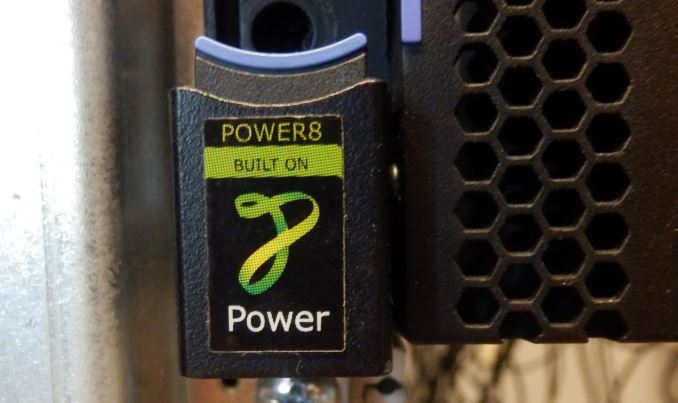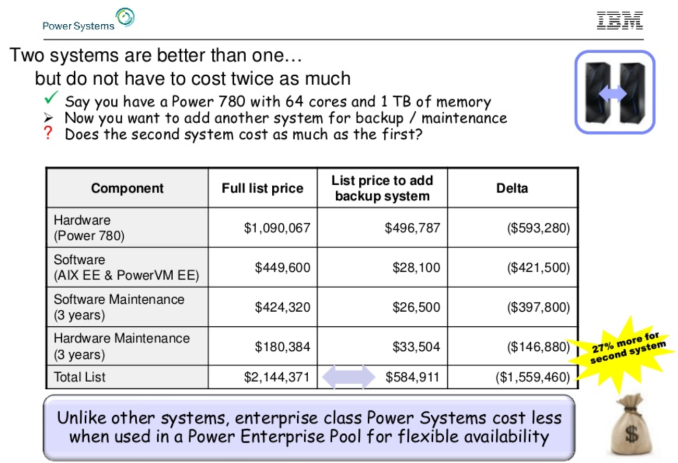The IBM POWER8 Review: Challenging the Intel Xeon
by Johan De Gelas on November 6, 2015 8:00 AM EST- Posted in
- IT Computing
- CPUs
- Enterprise
- Enterprise CPUs
- IBM
- POWER
- POWER8

Five years. That is how much time has passed since we have seen an affordable server processor that could keep up with or even beat Intel's best Xeons. These days no less than 95% of the server CPUs shipped are Intel Xeons. A few years ago, it looked like ARM servers were going to shake up the market this year, but to cut a long story short, it looks like the IBM POWER8 chip is probably the only viable alternative for the time being.
That was also noticeable in our Xeon E7 review, which was much more popular than we ever hoped. One of the reasons was the inclusion of a few IBM POWER8 benchmarks. We admit that the article was however incomplete: the POWER8 development machine we tested was a virtual machine with only 1 core, 8 threads and 2 GB of RAM, which is not enough to do any thorough server testing.
After seeing the reader interest in POWER8 in that previous article, we decided to investigate the matter further. To that end we met with Franz Bourlet, an enthusiastic technical sales engineer at IBM and he made sure we got access to an IBM S822L server. Thanks to Franz and the good people of Arrow Enterprise Computing Solutions, Arrow was able to lend us an IBM S822L server for our testing.
A Real Alternative?
Some of you may argue that the POWER based servers have been around for years now. But the slide below illustrates what we typically associated IBM's POWER range with:
Proudly, the IBM sales team states that you can save 1.5 million dollars after you have paid them 2 million dollars for your high-end 780 system. There is definitely a market for such hugely expensive and robust server systems as high end RISC machines are good for about 50,000 clients. But frankly for most of us, those systems are nothing more than an expensive curiosity.
Availability can be handled by software and most of us are looking/forced to reduce our capital expenses rather than increase them. We want fast, "reliable enough" servers at low costs that are easy to service. And that is exactly the reason why the single and dual sockets Xeon servers have been so popular the past decade. Can an IBM POWER server be a real alternative to the typical Xeon E5 server? The short but vague answer: a lot has changed in the past years and months. So yes, maybe.











146 Comments
View All Comments
extide - Friday, November 6, 2015 - link
No he meant that in a lot of the european countries they use the dot as a comma, so it would be 50.000 to mean 50 thousand.Murloc - Sunday, November 8, 2015 - link
the international system dictates that , and . are the same thing, and as a separator you should use a space.In many countries in Europe, ' is also used. That's fine too as there is no ambiguity.
Using . and , for anything that is not the decimal separator in international websites just creates confusion imho.
I guess AT doesn't have a style book though.
duploxxx - Friday, November 6, 2015 - link
nice review.but Xeon is not 95% of the market. AMD is still just a bit above 5% on its own. so it deserves a bit salt :) not to mention the fact that competition is good for all of us. if reviewers continue like this all narrowed readers will think there is no competition.
silverblue - Friday, November 6, 2015 - link
I'm left wondering what a Steamroller-based 16+ core CPU would do here, considering multithreading is better than with previous models. Yes, the Xeons have a large single-threading lead, but more cores = good in the server world, not to mention that such a CPU would severely undercut the price of the competition.Shame it isn't ever going to happen!
lmcd - Friday, November 6, 2015 - link
Or even an Excavator! It's a shame AMD didn't just keep Bulldozer developing internally until at least Piledriver, and iterate on Thuban.Kevin G - Saturday, November 7, 2015 - link
AMD killed off both Streamroller and Excavator chips early on as the Bulldozer and Piledriver chips weren't as competitive. More importantly, OEMs simply were not interested even if those parts were upgrades based upon existing designs. Thus the great AMD server drought began as they effectively have left that market and are hoping for a return with Zen.Also I should point out that Seattle, AMD's first ARM based Opteron has yet to arrive. This was supposed to be out a year ago and keep AMD's server business going throughout 2015 during the wait for Zen and K12 in 2016. Well K12 has already been delayed into 2017 and Seattle is no where to be found in commercial systems (there are a handle of Seattle developer boards).
JoeMonco - Saturday, November 7, 2015 - link
When you account for only 5% of the market while the other side commands 95%, you aren't really much of a credible competitor.xype - Sunday, November 8, 2015 - link
That’s not always correct, though. You can have 5% of the market and 20% of the profits, for example, which would put you in a way better position than your competitors (because only a small increase in market share would pay big time).Murloc - Sunday, November 8, 2015 - link
that applies more to consumer products, e.g. apple.dgingeri - Friday, November 6, 2015 - link
I've been dealing with IBM Power based machines for 5 years now. Such experience has only given me a major disdain for AIX.I do NOT advise it for anyone. It sucks to work on. There is a certain consistent, spartan logic to it, but it is difficult to learn, and learning materials are EXTREMELY expensive. I never liked the idea of paying $12,000 for a one week class that taught me barely a tenth of what I needed to know to run an AIX network. (My company paid for the class, but I could not get them to pay for the rest of them, for some reason.) This makes people who can support AIX extremely expensive to employ. Figure on paying twice the rate of a Windows admin in order to employ an AIX admin. Then there is the massive expense of maintenance agreements. Even the software only maintenance agreement, just to get patches for AIX, is $4000 per year per system. They may be competitive in cost up front, but they drain money like vampires to maintain.
Even the most modern IBM Power based machine takes 20-30 minutes to reboot or power up due to POST diagnostics. That alone is annoying enough to make me avoid AIX as much as I can.